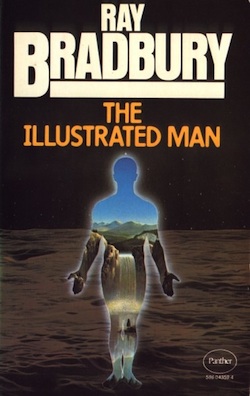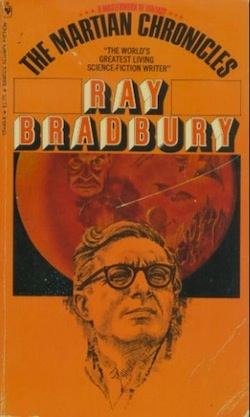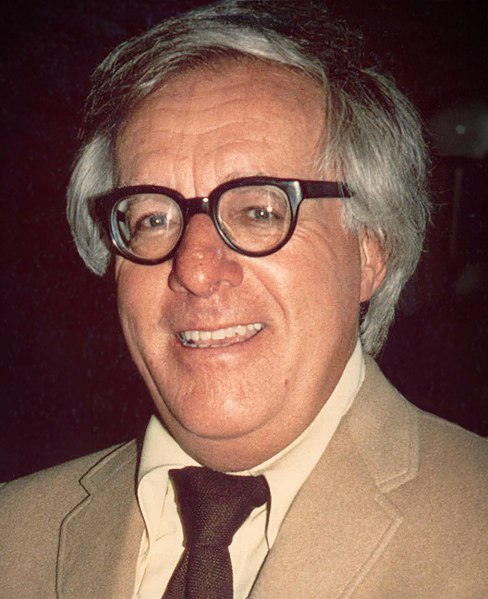In a bar last week, a man I’d just met was telling me all about how Gene Roddenberry wrote an episode of The Twilight Zone. Not wanting to offend the guy, I gently said I was 100% confident that Gene Roddenberry never wrote for The Twilight Zone. My new friend insisted I was wrong, betting me a beer that Roddenberry wrote the episode about the “electric body.”
“You mean, ‘I Sing the Body Electric’?” I said.
“Yep. That’s the one. Best episode. Roddenberry.”
“Bradbury.” I said.
“Yep. Roddenberry.”
Though I never did get the beer out of the guy, the unrelenting fame and ubiquity of Ray Bradbury did , once again, occur to me. Like Vonnegut, Bradbury enjoys a great deal of genre crossover appeal. Though my barfly friend was confused about names, he was also familiar with the other Bradbury titles I rattled off (though still attributing them to Roddenberry.) The point is, everyone has heard of Ray Bradbury, even people who know nothing about science fiction. But why? Was Bradbury the original genre buster?
It’s hard to overstate the abundance of material Bradbury has produced. Though he hasn’t dominated nearly every category of the Dewey Decimal system like Asimov, the man has put out a tremendous amount of work. He also has a great deal gravitas with the mainstream owing largely to the immense popularity of Fahrenheit 451. Notably, Bradbury recently allowed this famous novel to be distributed digitally, a notion he resisted for quite some time. I’m sure he was probably the least delighted of anyone in the world by the brand names “Kindle” or “Fire.”
 Regardless, Fahrenheit 451 has the kind of fame of a novel like To Kill a Mockingbird insofar as it tops tons of high school and undergraduate reading lists. These kinds of reading lists are often lousy with cautionary tales, so this is unsurprising. Further, as I’ve pointed out before, exceedingly grim, or depressing SF novels like 1984 or Fahrenheit 451 have a somewhat easier time grossing genre divides than other kinds of SF. And yet, Bradbury’s other work is far more upbeat than his famous book burning dystopia. Unlike the traditional novel structure of Fahrenheit 451, the format Bradbury more commonly employs is that of a series of vignettes which form a larger narrative or thematic point. He does this most notably with The Martian Chronicles, The Illustrated Man, and Dandelion Wine.
Regardless, Fahrenheit 451 has the kind of fame of a novel like To Kill a Mockingbird insofar as it tops tons of high school and undergraduate reading lists. These kinds of reading lists are often lousy with cautionary tales, so this is unsurprising. Further, as I’ve pointed out before, exceedingly grim, or depressing SF novels like 1984 or Fahrenheit 451 have a somewhat easier time grossing genre divides than other kinds of SF. And yet, Bradbury’s other work is far more upbeat than his famous book burning dystopia. Unlike the traditional novel structure of Fahrenheit 451, the format Bradbury more commonly employs is that of a series of vignettes which form a larger narrative or thematic point. He does this most notably with The Martian Chronicles, The Illustrated Man, and Dandelion Wine.
Other than allowing Bradbury to write these stories individually and then cobble them together into a novel later, there’s another advantage to this format: it’s accessible. A large sprawling world-building heavy SF novel is daunting to a reader who might be on the fence about rocket ships and aliens. Bradbury dispenses with this problem in The Martian Chronicles by using the connected vignette format. Not sure you want to read a whole book about people settling on Mars? That’s okay, just try this one short story and see if you like it.
The other reason this approach creates a crossover into mainstream readership is that a novel in stories is inherently perceived as literary. That’s because there’s another level of artistry to pulling it off beyond just the writing. Sure, the framing mechanism of the Illustrated Man in The Illustrated Man might seem a little hokey, but it’s fun for the reader to think about how all these stories are coexisting together on someone’s body. And in terms of the way we worry about continuity in novels, a collection of connected stories allows for some of that worry to dissipate. In short, Bradbury was not a novelist, he was a spinner of short yarns, which when he allowed free association, came together in some kind of larger whole. He cops to it in his essay “The Long Road to Mars” which deals with how The Martian Chronicles came to be. In it, he relates a conversation between himself and a publisher at Doubleday serendipitously named Walter Bradbury. The two are having breakfast and Ray Bradbury is telling Walter that he doesn’t have a novel in him. Walter responds:
“I think you’ve already written a novel.”
“What?” I said, “and when?”
“What about all those Martian stories you’ve published in the past four years?” he replied. “Isn’t there a common thread buried thre? Couldn’t you sew them together, make some sort of tapestry, half-cousin to a novel?”
“My god!” I said.
“Yes?”
“My god.”
 Bradbury goes on to say that he may have never put out The Martian Chronicles if it weren’t for this conversation, which for my money, put Bradbury on the path to having genre crossover. He in way, he pioneered a novel as stories and made it a viable and vibrant concept. Would we have novels like Cloud Atlas or A Visit from The Good Squad now if it weren’t for Bradbury’s Martian Chronicles or The Illustrated Man? I think the answer is definitely no. The act of messing with the format of what a novel is or is supposed to be is part of what speculative fiction is all about. A novel in stories is sort of like reading a novel from an alternate universe.
Bradbury goes on to say that he may have never put out The Martian Chronicles if it weren’t for this conversation, which for my money, put Bradbury on the path to having genre crossover. He in way, he pioneered a novel as stories and made it a viable and vibrant concept. Would we have novels like Cloud Atlas or A Visit from The Good Squad now if it weren’t for Bradbury’s Martian Chronicles or The Illustrated Man? I think the answer is definitely no. The act of messing with the format of what a novel is or is supposed to be is part of what speculative fiction is all about. A novel in stories is sort of like reading a novel from an alternate universe.
Famously, Bradbury had no real aspirations to be well respected or well thought of in literary circles, and constantly made a point to talk about how writing simply made him happy. Proof? The first essay in Zen in the Art of Writing is called “The Joy of Writing.” Despite some of his dark cautionary tales, Bradbury himself seems to usually rally for a more upbeat approach the art form of prose. Ray Bradbury is not a tortured artist and mostly wants you to have a good time reading his books. Sometimes this has tricked a mainstream readership into some magical realism, and sometimes into some horror. And other times, it’s put them on a rocket to Mars, whether they wanted to go or not.
Because Bradbury’s books are so numerous, recommending the various titles I’ve mentioned above seems a bit pedestrian. Instead, I’ll say if someone enjoys books which skip in and out of genre, or like short story collections which seem to have an overall point (if not a connected story) then you can’t go wrong with Bradbury’s 2004 collection The Cat’s Pajamas. I’ll not ruin a single story for you in this collection. But it’s worth looking at, if only to remember the other important thing about Bradbury; he’s never stopped writing.
And for the final proof that Bradbury has the most mainstream appeal of any SF writer: there’s a reason why this video exists:(Totally NSFW, but also great.)
Ryan Britt is the staff writer for Tor.com. He is the creator and curator of Genre in the Mainstream. His inials are also RB.










